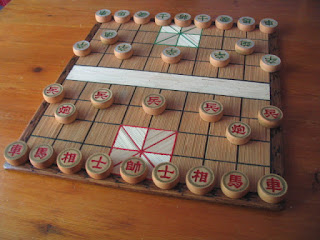I finally ended up with a board which basically consists of cocktail sticks, lots of cocktail sticks: well over 1000 of them! Yes, it took a lot of time finishing it.
'Mijn Kees' and I used the board a lot when I still lived in the Netherlands, and, for a while after I moved to the UK, I had it out when we played games over email.
Fast forward something like 20 years: I still had the pieces in a drawer, while the board had ended up in the back of the shed, damaged and dirty. It clearly was in need of some TLC!
Time to clean it up, restore it, and, where possible, make it look even nicer than it did originally. Damaged sticks in the 'river' were removed, and the 'river' was given a fresh lick of black paint in order to make it match the black lines of the board better.
I then took the decision to use cocktail sticks for inlaying the 'river' as well, but with their orientation turned 90 degrees compared to the rest of the board. Time had given the original cocktail sticks a somewhat darker colour, which actually worked well as it enhanced the contrast with the 'river'.
Next step was to inlay the two 'palaces', with cocktail sticks at a 45 degree angle to those on the main board.


Edges, made from matchsticks, were cleaned, sanded down, and finally dark-varnished.
Final step in the restoration was to clean up the pieces, and my Xiangqi set had been brought back to life again, looking better than ever!

This being the third chess board I ever made, I'm still pretty chuffed with it close to 30 years later. Very glad that this one did survive!








